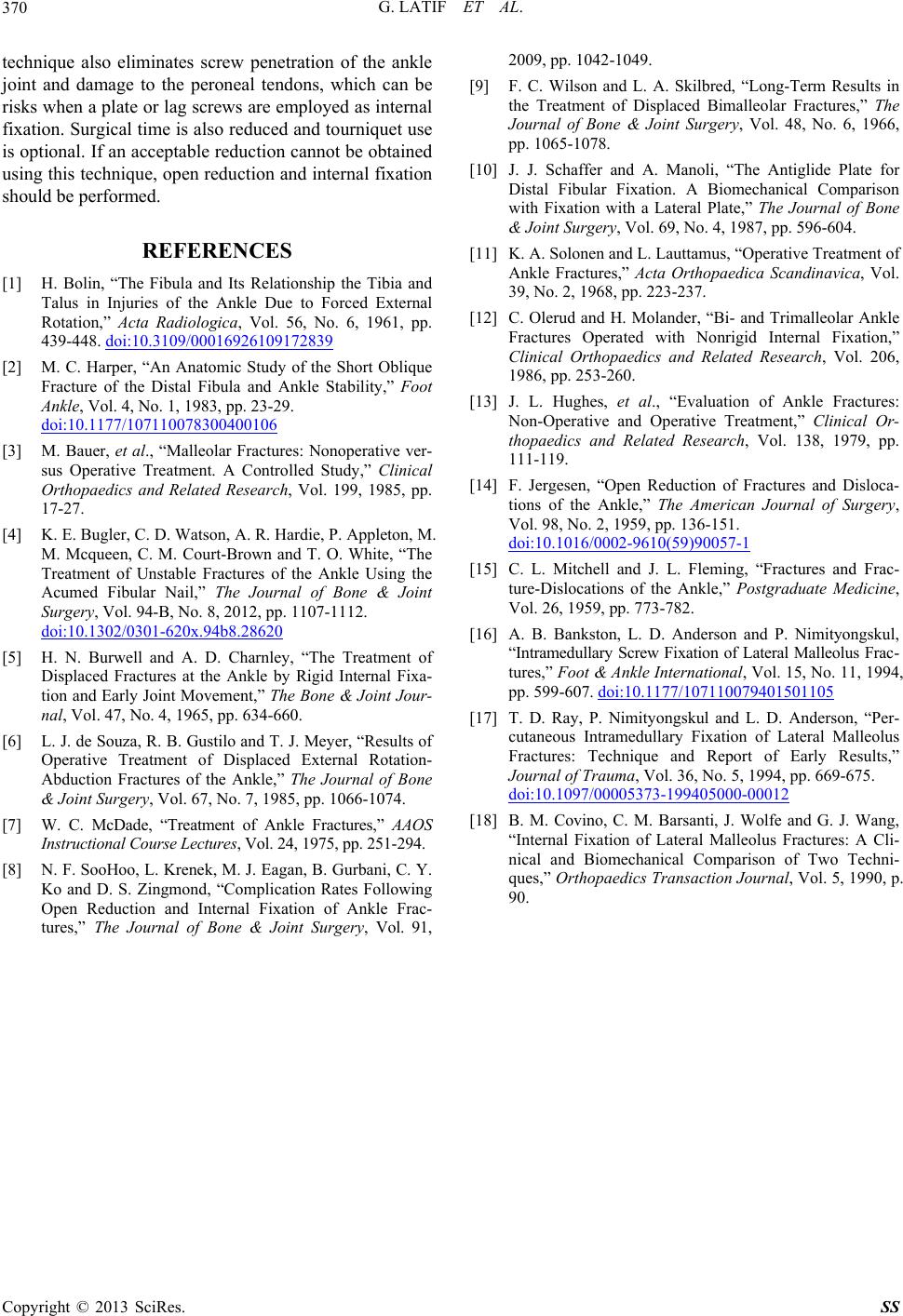
G. LATIF ET AL.
Copyright © 2013 SciRes. SS
370
technique also eliminates screw penetration of the ankle
joint and damage to the peroneal tendons, which can be
risks when a plate or lag screws are employed as internal
fixation. Surgical time is also reduced and tourniquet use
is optional. If an acceptable reduction cannot be obtained
using this technique, open reduction and internal fixation
should b e p erformed.
REFERENCES
[1] H. Bolin, “The Fibula and Its Relationship the Tibia and
Talus in Injuries of the Ankle Due to Forced External
Rotation,” Acta Radiologica, Vol. 56, No. 6, 1961, pp.
439-448. doi:10.3109/00016926109172839
[2] M. C. Harper, “An Anatomic Study of the Short Oblique
Fracture of the Distal Fibula and Ankle Stability,” Foot
Ankle, Vol. 4, No. 1, 1983, pp. 23-29.
doi:10.1177/107110078300400106
[3] M. Bauer, et al., “Malleolar Fractures: Nonoperative ver-
sus Operative Treatment. A Controlled Study,” Clinical
Orthopaedics and Related Research, Vol. 199, 1985, pp.
17-27.
[4] K. E. Bugler, C. D. Watson, A. R. Hardie, P. Appleton, M.
M. Mcqueen, C. M. Court-Brown and T. O. White, “The
Treatment of Unstable Fractures of the Ankle Using the
Acumed Fibular Nail,” The Journal of Bone & Joint
Surgery, Vol. 94-B, No. 8, 2012, pp. 1107-1112.
doi:10.1302/0301-620x.94b8.28620
[5] H. N. Burwell and A. D. Charnley, “The Treatment of
Displaced Fractures at the Ankle by Rigid Internal Fixa-
tion and Early Joint Movement,” The Bone & Joint Jour-
nal, Vol. 47, No. 4, 1965, pp. 634-660.
[6] L. J. de Souza, R. B. Gustilo and T. J. Meyer, “Results of
Operative Treatment of Displaced External Rotation-
Abduction Fractures of the Ankle,” The Journal of Bone
& Joint Surgery, Vol. 67, No. 7, 1985, pp. 1066-1074.
[7] W. C. McDade, “Treatment of Ankle Fractures,” AAOS
Instructional Course Lectures, Vol. 24, 1975, pp. 251-294.
[8] N. F. SooHoo, L. Krenek, M. J. Eagan, B. Gurbani, C. Y.
Ko and D. S. Zingmond, “Complication Rates Following
Open Reduction and Internal Fixation of Ankle Frac-
tures,” The Journal of Bone & Joint Surgery, Vol. 91,
2009, pp. 1042-1049.
[9] F. C. Wilson and L. A. Skilbred, “Long-Term Results in
the Treatment of Displaced Bimalleolar Fractures,” The
Journal of Bone & Joint Surgery, Vol. 48, No. 6, 1966,
pp. 1065-1078.
[10] J. J. Schaffer and A. Manoli, “The Antiglide Plate for
Distal Fibular Fixation. A Biomechanical Comparison
with Fixation with a Lateral Plate,” The Journal of Bone
& Joint Surgery, Vol. 69, No. 4, 1987, pp. 596-604.
[11] K. A. Solonen and L. Lauttamus, “Operative Treatment of
Ankle Fractures,” Acta Orthopaedica Scandinavica, Vol.
39, No. 2, 1968, pp. 223-237.
[12] C. Olerud and H. Molander, “Bi- and Trimalleolar Ankle
Fractures Operated with Nonrigid Internal Fixation,”
Clinical Orthopaedics and Related Research, Vol. 206,
1986, pp. 253-260.
[13] J. L. Hughes, et al., “Evaluation of Ankle Fractures:
Non-Operative and Operative Treatment,” Clinical Or-
thopaedics and Related Research, Vol. 138, 1979, pp.
111-119.
[14] F. Jergesen, “Open Reduction of Fractures and Disloca-
tions of the Ankle,” The American Journal of Surgery,
Vol. 98, No. 2, 1959, pp. 136-151.
doi:10.1016/0002-9610(59)90057-1
[15] C. L. Mitchell and J. L. Fleming, “Fractures and Frac-
ture-Dislocations of the Ankle,” Postgraduate Medicine,
Vol. 26, 1959, pp. 773-782.
[16] A. B. Bankston, L. D. Anderson and P. Nimityongskul,
“Intramedullary Screw Fixation of Lateral Malleolus Frac-
tures,” Foot & Ankle International, Vol. 15, No. 11, 1994,
pp. 599-607. doi:10.1177/107110079401501105
[17] T. D. Ray, P. Nimityongskul and L. D. Anderson, “Per-
cutaneous Intramedullary Fixation of Lateral Malleolus
Fractures: Technique and Report of Early Results,”
Journal of Trauma, Vol. 36, No. 5, 1994, pp. 669-675.
doi:10.1097/00005373-199405000-00012
[18] B. M. Covino, C. M. Barsanti, J. Wolfe and G. J. Wang,
“Internal Fixation of Lateral Malleolus Fractures: A Cli-
nical and Biomechanical Comparison of Two Techni-
ques,” Orthopaedics Transaction Journal, Vol. 5, 1990, p.
90.